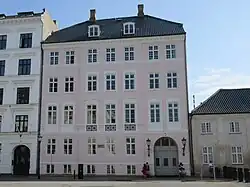| Niels Aagesen House | |
|---|---|
Niels Aagesens Gård | |
 | |
| General information | |
| Location | Amaliegade 22, Copenhagen, Denmark |
| Coordinates | 55°41′5.48″N 12°35′39.01″E / 55.6848556°N 12.5941694°E |
| Completed | 1751 |
| Design and construction | |
| Architect(s) | Niels Eigtved |
The Niels Aagesen House (Danish: Niels Aagesens Gård) is a property at Amaliegade 22 in the Frederiksstaden district of central Copenhagen, Denmark. It was listed on the Danish register of protected buildigns and places in 1945. A plaque on the facade commemorates that the poet Adam Oehlenschläger died in the building on 20 November 1840. Other notable former residents include the naval officer Steen Andersen Bille, Tivoli Gardens-founder Georg Carstensen, medical doctor Ole Bang, diplomat and minister H. E. Reedtz (1800-1857), politician Christian Albrecht Bluhme (1794-1866), General Christian de Meza (1792-1865) and politician Aleth Hansen.
History
18th century
The house was built for Niels Aagesen in 1750-1751. The building was like many of the other early Frederiksstaden buildings constructed to designs by Niels Eigtved who had also created the masterplan for the new neighborhood. Aagesen's property was listed in the new cadastre of 1756 as part of the vast No. 71 in St, Ann's East Quarter. It was later referred to as No. 71 F 2. The property was marked on Christian Gedde's 1757 cadastral map of St. Ann's East Quarter as No. 336-
The writer and historian Tyge Rothe (1731-1795) resided in the building in 1772. Joachim Otto Schack-Rathlou (1728-1800) were among the residents from 1773 to 1782.
Haxthausen family
The property was at some point acquired by Gregers Christian Haxthausen (1733-1802). He resided in the building with his second wife Anne Elisabeth Juel and their 24-year-old son Ove Christian Haxthausen at the 1801 census. Their staff comprised two cooks (one male and one female), three male servants, three maids, a coachman and a caretaker.[1]
The property was listed in the new cadastre of 1806 as No. 126 in St. Ann's East Quarter. It belonged to one Countess Haxthausen at that time.
Bille family
In c. 1816, Steen Andersen Bille (1751-1833) bought the building. From 1803 to 1715, he had lived in an apartment in the Bernstorff Mansion. Bille lived there until his death in 1833. Frederikke Vilhelmine Charlott Bille (née Bornemann, 1770-1851), his widow, resided in the building with his wife her granddaughter Frederike Marie Levetzau, three male servants and three maids.[2]
1840–1900

Niels Christensen, a concierge, resided in the building at the 1840 census. He lived there with his wife Juliane Andrea Christensen (née Holst) and their six children (aged three to 14).[3]
Niels Christensen was still the concierge of the building at the 1845 census. He lived there with his wife Juliane Holst and four children (aged seven to 12).[4]
The building was later acquired by master builder Christian Olsen Aagaard (1790–1858). In 1845-1846, he heighten3ed the building. Aagaard had previously also engaged in a number of other construction projects, including the construction of Store Kannikestræde 15, Store Kongensgade 23–25 and Krigsråd Mørks Minde.
Tivoli Gardens-founder Georg Carstensen lived in the building in 1847.
The medical doctor Ole Bang resided in the second-floor apartment at the 1850 census.[5] Ulrik Nicolai Fugl (1807-1867), a military procecutor, notarius publicus in Copenhagen and later bank manager of Privatbanken, resided on the third floor with his wife Henriette Caroline Augusta Fugl (née Moe, 1719-1761), their six children, a nanny, a makle servant and a maid.[6]
In 1850, Adam Oehlenschläger moved to an apartment in the building. He died there on 20 November the same year. The diplomat and minister H. E. Reedtz (1800-1857) lived there in the early 1850s and the politician Christian Albrecht Bluhme (1794-1866) lived there in 1855. General Christian de Meza (1792-1865) lived in the building in 1858 and again in 1864-1865. Aleth Hansen, who had recently served as Minister of Education, lived briefly in the building in 1870.[7]
20th and 21st centuries
The military physician Martin Ingwersen Grønlund (1856-) was the owner of the building in 1908. He was a board member of the Association of Military Physicians.[8]
Princess Thyra acquired the building in 1930. She lived there until her death in 1945.[9]
Shortly after World War II, Amaliegade 22 was acquired by publisher Valdemar Richter-Friis (1896–1976).
In the 2000s, Amaliegade 22s belonged to Poul Kjærgaard Balle-Petersen. In 2008, he sold it for DKK 86 million to Christian Levin. In 2017, Levin sold it to Claus Molbech Bendtsen for DKK 135 million.[10]
Today

The building has a total floor area of 2,673 square metres, distributed among 11 leases.[11] The tenants include Kønig & Partnere Advokatfirma and Sonha Toft.
References
- ↑ "Folketælling -1834 - Gregers Christian Haxthausen". nishfamilysearch.dk (in Danish). Retrieved 23 March 2021.
- ↑ "Folketælling -1834 - Frederike Wilhelmine Charlotte Bille født Bornemann". nishfamilysearch.dk (in Danish). Retrieved 23 March 2021.
- ↑ "Folketælling -1840 - Amaliegade 126". nishfamilysearch.dk (in Danish). Retrieved 23 March 2021.
- ↑ "Folketælling -1845 - Amaliegade No.126". nishfamilysearch.dk (in Danish). Retrieved 23 March 2021.
- ↑ "Ole Lundt Bang". gedcom.slaegt.d (in Danish). Retrieved 16 June 2022.
- ↑ "APPELBY, Anna Agathe Nancy 1769-1838 og hendes familie". Kulturstyrelsen (in Danish). Retrieved 16 June 2022.
- ↑ "Amaliegade 22-22a" (in Danish). Nielsen indenforvoldene.dk. Retrieved 5 April 2017.
- ↑ "Dandsk portrætgalleri:" (PDF). slaegtsbibliotek.dk (in Danish). Retrieved 16 June 2022.
- ↑ Wu, Philip. "Huset Glücksborgs tidligere kongelige privatboliger i Storkøbenhavn" (in Danish). Booksdemand. Retrieved 16 June 2022.
- ↑ "Diskret advokat runder 400 mio. kr. i historiske ejendomme i år" (in Danish). EjendomsWatch. Retrieved 12 June 2021.
- ↑ "Amaliegade 22 – et ledigt hjem i Frederiksstaden". my-pleasure.dk (in Danish). Retrieved 16 June 2022.